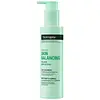What's inside
What's inside
 Key Ingredients
Key Ingredients

 Benefits
Benefits

 Concerns
Concerns

 Ingredients Side-by-side
Ingredients Side-by-side

Water
Skin ConditioningDisodium Laureth Sulfosuccinate
CleansingOctyldodecanol
EmollientPolyacrylate-33
Propanediol
SolventPolyglyceryl-2 Caprate
EmulsifyingSodium Cocoyl Isethionate
CleansingMontmorillonite
AbsorbentKaolin
AbrasiveOlive Oil Polyglyceryl-6 Esters
EmollientRice Oil Glycereth-8 Esters
CleansingPhospholipids
Skin ConditioningSodium Lauroamphoacetate
CleansingBisabolol
MaskingPentylene Glycol
Skin ConditioningSodium Chloride
MaskingSodium Phytate
Caprylyl Glycol
EmollientDehydroacetic Acid
PreservativeBenzoic Acid
MaskingPropylene Carbonate
SolventLinalool
PerfumingFarnesol
PerfumingWater, Disodium Laureth Sulfosuccinate, Octyldodecanol, Polyacrylate-33, Propanediol, Polyglyceryl-2 Caprate, Sodium Cocoyl Isethionate, Montmorillonite, Kaolin, Olive Oil Polyglyceryl-6 Esters, Rice Oil Glycereth-8 Esters, Phospholipids, Sodium Lauroamphoacetate, Bisabolol, Pentylene Glycol, Sodium Chloride, Sodium Phytate, Caprylyl Glycol, Dehydroacetic Acid, Benzoic Acid, Propylene Carbonate, Linalool, Farnesol
 Reviews
Reviews

Ingredients Explained
These ingredients are found in both products.
Ingredients higher up in an ingredient list are typically present in a larger amount.
Kaolin is a clay. It is used for oil control and to help minimize pores. Like other clays, kaolin has the ability to absorb excess sebum or oil. This can help clean out pores and mattify the skin.
Some types of kaolin may have exfoliating properties. When water is added to kaolin, it becomes a paste with small abrasive particles.
Most kaolin is a white color, but may be pink/orange/red depending on where it comes from.
The name 'kaolin' comes from a Chinese village named 'Gaoling'. Kaolin clay comes from rocks rich in kaolinite. Kaolinite, the mineral, has a silicate layered structure. Kaolinite is formed from chemical weathering of aluminum siilicate minerals.
Besides skincare, kaolin is commonly used to make glossy paper, in ceramics, toothpaste, and as medicine to soothe stomach issues.
Learn more about KaolinWater. It's the most common cosmetic ingredient of all. You'll usually see it at the top of ingredient lists, meaning that it makes up the largest part of the product.
So why is it so popular? Water most often acts as a solvent - this means that it helps dissolve other ingredients into the formulation.
You'll also recognize water as that liquid we all need to stay alive. If you see this, drink a glass of water. Stay hydrated!
Learn more about Water